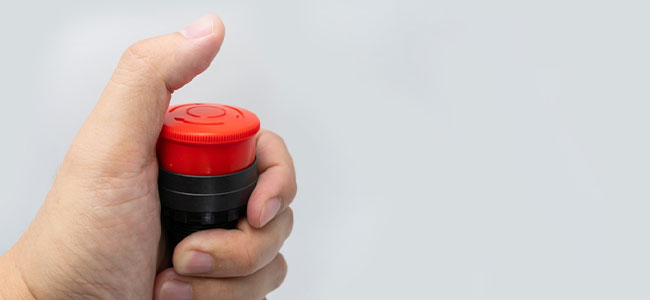
Panic Buttons: When (and When Not) to Use These Devices
Panic button devices are synonymous with emergency help or immediate action, but this concept has evolved into a tool for the occupational health and safety of employees in sectors such as healthcare or hotels and hospitality.
- By Gen Handley
- Nov 09, 2023
The recognizable large red panic button has become synonymous with emergency help or some kind of instant, important action. Today, panic button devices are available in a number of different compact shapes and sizes. However, the design originated in WWII when the Air Force installed “panic buttons” for pilots to ring when the main communication system was down, and they had to abandon the aircraft.
This concept has evolved in many different directions over time, becoming a tool for the occupational health and safety of employees in sectors such as healthcare or hotels and hospitality. These are industries where there is potential for violence, assault and other on-the-spot emergencies.
Types of Panic Button Devices Available
The panic button has also evolved into several different designs for different jobs and types of work, depending on the occupational hazards and risk for violence.
- Wired panic alarms are hooked up to a specific location, usually somewhere discreet such as below a desk or countertop.
- Wireless panic alarms are not linked to a particular place and can be accessed on a separate, mobile device using Bluetooth and Wi-fi networks.
- In-app panic buttons are not located on a separate device but on an existing smartphone and other devices.
Why Someone Might Need a Panic Button
A panic button device is needed in situations where occupational violence is a serious possibility. Industries in which employees may experience such circumstances include healthcare and social services work (both in the hospital and the community), hotel and hospitality, retail and taxi drivers, who are 20 times more likely to be murdered than any other workers according to OSHA.
In some cases, local government or industry may have regulations requiring employees to carry a panic button at work. An example of this is the US hotel and hospitality sector which—in certain states and cities such as New Jersey—is making it mandatory for employers and hotels to equip their staff with panic buttons.
Workplace Violence Policy
Even if people are not required to carry a panic button while at work, the National Safety Council says managers and safety professionals “at every workplace should develop a policy on violence” that includes:
- An emergency action plan with employee training
- Simulation training exercises and scenarios with local law enforcement
- A documented and accessible zero-tolerance policy toward workplace violence
Alternative Channels to Panic Buttons
While panic buttons and panic alarms have been around for a while, new technologies and safety strategies have emerged as well, offering more—and sometimes better—safety solutions to protect vulnerable employees.
- Safety check-ins.One of the most effective safety practices an employer can introduce is a schedule of safety check-ins, which require the employee to “check in” at predetermined times and after their shift to confirm their safety with their manager or safety monitor. While they can be performed manually, safety check-ins are most functional and reliable when using an automated system.
- Motion sensors in existing devices. Rather than purchasing new panic buttons, employers can utilize safety apps that use advanced motion sensors in existing devices like smartphones and tablets. Most people carry their smartphones on them almost always during work, and these safety apps empower their phones to monitor their safety.
The Benefits
So what are the benefits of using a panic button to protect the team? The most important benefit is how simple it is to use: just press a button. Additionally, panic buttons:
- Are easy to onboard and can be used as a proactive safety measure, such as pressing it when feeling threatened.
- Provide comfort and less stress with employees knowing they have a button to press for help in an emergency.
- Are compact and discreet, allowing the employee to press it without anyone in their presence knowing that they just requested help.
The Challenges
On the other hand, several challenges come with organizational panic button use for work safety. These include:
- Management and update challenges in which it is difficult to make changes to the system as well as add and remove staff.
- Accidental pushing of the button and accidentally triggering an emergency can be costly as well as embarrassing.
- Costs for additional hardware, devices and installation can add up, not to mention the time costs and onboarding.
- Complacency with the device which, when it is not used, can be forgotten in a drawer or somewhere unknown until something happens.
Panic buttons can be effective in certain work environments. However, they are limited in how they can protect employees and may require additional costs to the company. Violence is a piece of an overall safety picture and workers in these industries need solutions that mitigate all the risks they face regularly. There are many more comprehensive worker safety solutions available that help address a range of occupational hazards and risks in a range of different circumstances.
If you’re worried about violence in the workplace, assess all of the existing safety hazards and risks and find an OHS technology that will address the specific risks and unique conditions. The physical and emotional damage of workplace violence is deep and long-lasting. So it is the employer’s responsibility and priority to protect their people from its trauma.